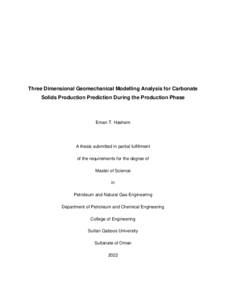Document
Three dimensional geomechanical modelling analysis for carbonate solids production prediction during the production phase.
Publisher
Sultan Qaboos University.
Gregorian
2022
Language
English
English abstract
In recent years, many high-producing carbonate reservoirs encountered significant solids
production associated with the reservoir fluids during depletion. The production of solid particles
from such rich reservoirs has caused concerning consequences ranging from the high operational
costs and safety hazards to dramatic drop in wells productivity. The onset of this problematic
phenomena is influenced by the stress distribution around the wellbore and the properties of the
reservoir rocks and fluids. Therefore, it is important to evaluate the potential of confronting solids
production during the life of the reservoir, and properly assess the need for any solids management
and control.
In this study, the onset of carbonate rocks geomechanical failure is estimated using a three
dimensional stability model. The stability model adopts the poroelastic constitutive law in
conjunction with the Mogi-Coulomb failure criterion. A sensitivity study is performed to identify
the model's critical inputs for Oman carbonates. It has been found that the stability model is
sensitive to the in-situ stresses followed by the rock geomechanical properties, that are cohesion
and friction angle for carbonate reservoirs. The impact of the intermediate principal stress on the
sensitivity was highlighted by comparing the sensitivity results using the three dimensional Mogi Coulomb failure criterion against the use of the classical Mohr-Coulomb failure criterion. It has
been observed that the intermediate principal stress significantly impacts carbonate solids
production prediction.
The adopted geomechanical approach in this study for carbonate shear failure during production
has been justified using three real field cases. The studied fields stress regimes are from all stress
regimes, that is, normal fault, strike slip and reverse fault. In all the different conditions, the applied
approach mimic carbonate fields at high level and encourages the utilization of the suggested
geomechanical model.
Member of
Resource URL
Arabic abstract
في السنوات الأخيرة ، واجهت العديد من المكامن الجيرية عالية الإنتاج إنتاجا كبيًرا للجسيمات الصخرية الصلبة المصاحبة للمواد
الهيدروكربونية. تسبب إنتاج الجسيمات الصلبة من هذه المكامن الغنية في حدوث عواقب تتراوح بين ارتفاع تكاليف التشغيل
ومخاطر السلامة إلى انخفاض حاد في إنتاجية الآبار. تحدث هذه الظاهرة بسبب عوامل متعددة منها التركيز العالي للضغط حول
حفرة البئر وخصائص الصخور والموائع المخزنة في المكمن. لذلك، من المهم تقييم إمكانية حدوث مشكلة إنتاج الجسيمات الصلبة
الأبعاد فترة الإنتاج من المكمن، وتقييم الحاجة إلى إدارة المواد الصلبة والسيطرة عليها بشكل صحيح.
في هذه الدراسة ، تم تقدير بداية االنهيار الميكانيكي للصخور الجيرية باستخدام نموذج استقرار الآبار ثلاثي الأبعاد. يتبنى نموذج
الاستقرار القانون التأسيسي المرن بالاقتران مع معيار موجي-كولومب لانهيار الصخور. تم إجراء دراسة الحساسية لتحديد
المدخالت الحرجة للنموذج بنطاقات نموذجية للمكامن الجيرية في عمان. نتائج النموذج تتأثر بشكل كبير بالضغوط األرضية في
الحقول تليها في التأثير الخصائص الجيوميكانيكية للصخور، وهي زاوية التماسك واالحتكاك. تمت دراسة تأثير الضغط األساسي
الوسيط من الأبعاد مقارنة النتائج باستخدام معيار موجي-كولوم ثلاثي الأبعاد لانهيار الصخور مع معيار موهر-كولومب الكالسيكي
لانهيار الصخور.
تم في هذه الدراسة تحسين محاكاة الصخور الجيرية وتعزيز المنهجية في األدبيات العلمية والتطبيقات العملية في بناء النمذجة
الجيوميكانيكية في الصخور الجيرية لتنبؤ بداية فقدان االستقرار في المكامن الجيرية. وقد تم إثبات جودة المنهجية الجيوميكانيكية
المتبعة في هذه الدراسة لتنبؤ حدوث مشكلة انتاج المواد الصلبة من الصخور الجيرية من الأبعاد التطبيق على ثالث حالات ميدانية
حقيقية لحقول نفط متنوعة.
الهيدروكربونية. تسبب إنتاج الجسيمات الصلبة من هذه المكامن الغنية في حدوث عواقب تتراوح بين ارتفاع تكاليف التشغيل
ومخاطر السلامة إلى انخفاض حاد في إنتاجية الآبار. تحدث هذه الظاهرة بسبب عوامل متعددة منها التركيز العالي للضغط حول
حفرة البئر وخصائص الصخور والموائع المخزنة في المكمن. لذلك، من المهم تقييم إمكانية حدوث مشكلة إنتاج الجسيمات الصلبة
الأبعاد فترة الإنتاج من المكمن، وتقييم الحاجة إلى إدارة المواد الصلبة والسيطرة عليها بشكل صحيح.
في هذه الدراسة ، تم تقدير بداية االنهيار الميكانيكي للصخور الجيرية باستخدام نموذج استقرار الآبار ثلاثي الأبعاد. يتبنى نموذج
الاستقرار القانون التأسيسي المرن بالاقتران مع معيار موجي-كولومب لانهيار الصخور. تم إجراء دراسة الحساسية لتحديد
المدخالت الحرجة للنموذج بنطاقات نموذجية للمكامن الجيرية في عمان. نتائج النموذج تتأثر بشكل كبير بالضغوط األرضية في
الحقول تليها في التأثير الخصائص الجيوميكانيكية للصخور، وهي زاوية التماسك واالحتكاك. تمت دراسة تأثير الضغط األساسي
الوسيط من الأبعاد مقارنة النتائج باستخدام معيار موجي-كولوم ثلاثي الأبعاد لانهيار الصخور مع معيار موهر-كولومب الكالسيكي
لانهيار الصخور.
تم في هذه الدراسة تحسين محاكاة الصخور الجيرية وتعزيز المنهجية في األدبيات العلمية والتطبيقات العملية في بناء النمذجة
الجيوميكانيكية في الصخور الجيرية لتنبؤ بداية فقدان االستقرار في المكامن الجيرية. وقد تم إثبات جودة المنهجية الجيوميكانيكية
المتبعة في هذه الدراسة لتنبؤ حدوث مشكلة انتاج المواد الصلبة من الصخور الجيرية من الأبعاد التطبيق على ثالث حالات ميدانية
حقيقية لحقول نفط متنوعة.
Category
Theses and Dissertations

